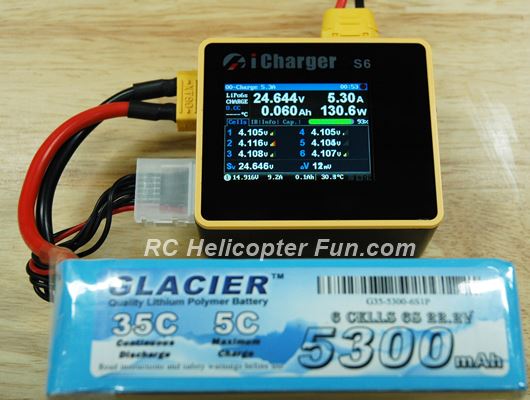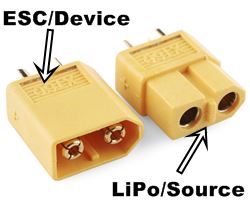LiPo Battery Balancing
What, Why & How - Safety & Benefits
by John Salt
What is LiPo Battery balancing and why is it so important?
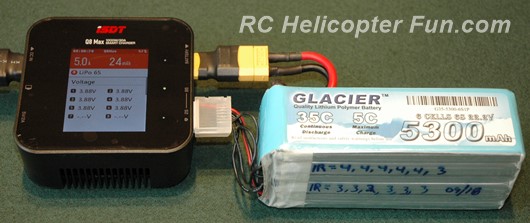 LiPo Balancing Fun!
LiPo Balancing Fun!Recall back on the LiPo battery charging page where we talked about the 100%, fully charged voltage of a LiPo battery cell being 4.20 volts? Well, here is where that number comes into play again.
For a single cell (1S) LiPo battery, you never have to worry about balancing because there is nothing to balance
The RC battery charger will automatically stop charging when the 100% charge voltage of 4.20 volts is reached in that single battery cell.
Balancing is required however on any LiPo battery pack that has more than one cell hooked in series. Why?
Because the RC charger can’t identify from different cells within the battery pack. One or more cells in the pack might be charging quicker or slower than the others and therefore might be over or undercharged when the pack has finished charging. Yes, the total voltage of the pack might be correct, but that doesn't mean the voltage of the cells are all the same.
Balancing simply ensures all the cells in a 2S or higher cell count LiPo battery pack are all at the same voltage potential; within about 0.01 volts (10 millivolts) of each other at the end of the charge cycle. This will ensure no cell/s in the LiPo battery pack become over charged which will ruin your battery pack, or become a safety concern with a large enough voltage difference between cells.
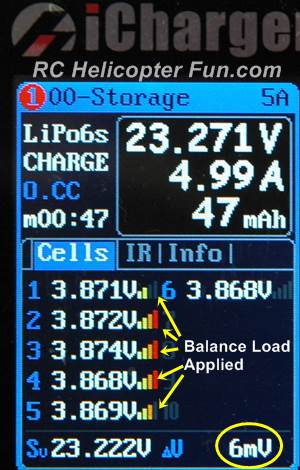
Some chargers will actually show you the LiPo battery balancing process in real time as shown in this photo while charging a 6-cell LiPo battery with my iCharger 4010 Duo.
There are individual resistive loads being applied to cells 1 - 5 (shown with yellow arrows) that are discharging these individual cells slightly to keep them all at the same voltage (within that 0.01 volt range).
The energy from the resistive loads on these cells is being converted into heat within the charger.
This method of placing a resistive load on each individual cell to keep it at the same voltage potential as the others is classified as "passive balancing".
The amount of load placed on each cell is shown by the bar graph beside the voltages; the more bars, the more load is being placed on the cell.
Circled in the bottom right corner, the maximum cell imbalance voltage of 6mV is displayed. This is the difference (delta voltage difference) between cell 6 @ 3.868V (the lowest cell), and cell 3 @ 3.874V (the highest cell).
These numbers constantly "dance" around during the charge cycle, always trying to maintain as little delta voltage difference between all cells as possible. With a good charger such as the iCharger here and a healthy LiPo battery pack, the balance delta is generally under 3mV when the pack has finished charging.
RC LiPo Battery Balancing Plugs/Taps
Okay, so now we know why an RC LiPo battery has to be balanced, the question now is how to do it?
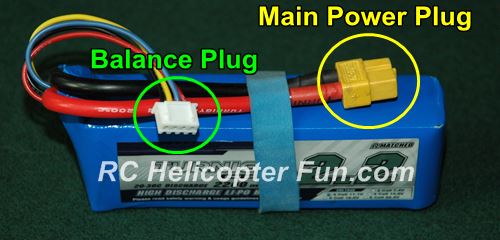
As pictured above, every 2S and higher multi celled RC LiPo battery will have what is called a balance plug; also called a balance tap. This plug allows individual charging or discharging of each cell in the battery pack.
The balance plug will have one extra pin/wire than there are number of cells in the pack. The battery in that photo is a 3S (3 cells), and as you can see it uses a 4 pin/wire balance plug. A 4S pack would have a 5 pin plug, a 5S would have a 6 pin plug, and so on.
Shown below is how these balance wires are connected to the individual cells of a 3S LiPo pack, allowing both charging or discharging of each cell independent of the other/s.
 RC LiPo Battery Wiring Schematic
RC LiPo Battery Wiring SchematicCharging LiPo Batteries With Balancer
The Three Primary Ways
1. Lipo’s can be balanced while charging the pack through the balance plug with a balancing charger.
This is the usual charging method as well on devices that have internal LiPo charging circuitry such as RC radios that support lithium battery packs.
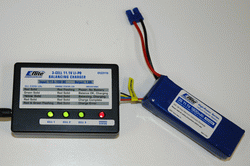 Charging Each Cell Individually Through The Balance Plug
Charging Each Cell Individually Through The Balance PlugThis method uses the charger (or internal charge circuitry) to individually charge each cell and ensure the voltages are the same in each cell as they charge.
Pictured right a dedicated 3 cell charger is charging a 3 cell RC LiPo battery through the balancing plug/tap. The limitation using the balance tap for charging is the maximum charge rate.
Since the gauge of balance plug wiring and the plug itself are small, this method only works on smaller LiPo's or charge rates not much higher than 2.5 amps maximum.
A good clue if you are pushing too many amps through the balance leads would be a warm/hot balance plug/wiring.
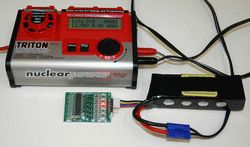 Charging Through The Main Plug & Balancing With An External Balancer
Charging Through The Main Plug & Balancing With An External Balancer2. LiPo’s can be balanced with a stand alone balancer such as a Blinky Balancer while the pack is being charged through the main power plug.
Pictrued left is a non-balancing computerized charger charging a 3 cell LiPo pack through the main power plug with the Blinky balancer hooked up to the balance plug.
The Blinky will monitor the voltage of each cell in the pack and apply a small load to discharge any cell that is indicating a charge voltage higher than the other cells in the pack, trying to keep all cells within about 0.02 volts (20 mV) of each other.
The biggest issue with these little external balancers, is they can't produce enough resistive load to balance out larger packs at higher charge rates.
Basically, don't use them on anything much larger than a 2000 mAh pack while charging it @ 1C or lower rates. It can also take a longgg... time to balance out the pack because the balancing load is so small.
3. Finally the best & most popular way to balance and charge an RC LiPo battery is by using a good computerized RC charger with built-in balance circuitry.
With this set-up (pictured above), the battery is charged through the main power plug and balanced through the balance plug.
The balance plug is plugged into the computerized charger's balance port (a balance or para-board could also be used).
The charger then puts a load (through the balance plug) on any cell/s the are drifting over the voltage of the others keeping them all equalized.
The 4 main reasons this LiPo battery balancing method is best:
- It's very adaptable for many different capacity and cell count/voltage packs.
- You can balance charge large packs at high currents as all the charge current is being sent through the large main power plug/connector.
- Balancing discharge currents are generally higher with good computerized charges which allows faster and more accurate balancing resulting in shorter charging times and heathier LiPo's.
- It's much safer! If the balance drain current for example can't keep up to the charger's larger charge current in order to keep all the cells balanced, the computerized charger will automatically throttle back the main charge current.
Most good computerized RC chargers with built in balance circuitry will also automatically select the correct cell count of battery (since they detect the number of cells through the balance plug); or warn you if you have the wrong cell count selected and thus wrong charge voltage selected.
This "auto cell detect" feature offers one more very useful level of "goof-proofness" (not sure if that's a real word, but for me it should be). This feature has saved my butt (and my LiPo packs) too often to count!
LiPo Battery Balancing Current - What is it?
Thought I better touch on balancing current because I do get a fair number of questions about it.
As I mentioned above with the balance current limitation of that little Blinky/similar external balancer; balance current is an important consideration when choosing your battery charger.
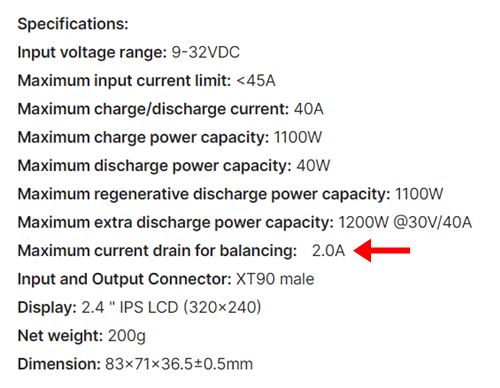 RC Charger LiPo Balancing Drain Current Specification
RC Charger LiPo Balancing Drain Current SpecificationThe more balance drain current (passive resistive load) a charger can place on each cell of the battery, the faster it will be able to balance out your LiPo, LiFe, Lion & LiHV multi celled battery packs as they charge.
If the balance current is very low, it can actually take longer to balance the pack than it does to charge it!
As I mentioned on my best RC battery charger page, I like to see at least a 1.0 Amp balance drain current when looking at any RC charger I might be considering on the specifications as pictured above with this iCharger charger example (red arrow).
You won't see many RC LiPo battery chargers have balance drain currents much over 2.0 Amps; again because the balance plugs & small gauge wiring going to the balancing plugs can't handle loads much higher than that. Speaking of balance plugs....
RC LiPo Battery Balancing Plug Types
Lipo battery balancing plugs/taps as I already mentioned, will have one more connector pin than the number of cells in the pack.
Here are the most common types of balance plugs:
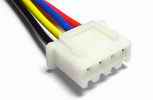
JST-XH Balance Plug
This is by far, the most common balancing plug type in use today. Used On: ACE, Align, CNHL, Eachine, E-Flite/Blade/Spektrum, EP Buddy, OMPHobby, Glacier, Gens-Ace, G-Force, Hextronic, Imax, Park Zone, Rhino, Turnigy, Nano-Tech, Pulse-Ultra, SMC, Venom, XK, Zippy, and many more .... !
I could just end here because in all likelihood, this is the only balance plug you'll ever run across; but may as well include a couple others that you should at least be aware of.
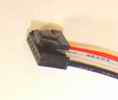
Thunder Power Balance Plug
Used On: Thunder Power, FlightPower, Apex, EVO, MPX, Outrage, and a few other battery brands.
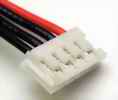
JST-EH Balance Plug
These are probably the least common type of balancing plug/tap, but you will find them on a few battery brands such as: Kokam, Graupner & Core.
You can get converters/adapters to use with different balancing plug configurations, but it is much easier and less costly if you just make sure you get the correct plug/tap that works with your charger/balance board when you purchase your LiPo battery. Again, 99% will likely be JST-XH.
RC LiPo Battery Main Power Connectors
Let's finish off this LiPo battery balancing topic with the main LiPo power plug/connector because they are also an important part of most LiPo balance charging methods.
I cover RC Battery Connector types on my LiPo Battery Connector Page in detail.
That page includes RC connector types, power ratings, pros/cons of various connectors, and how-to videos if you are unsure of how to properly solder, splice, or crimp RC connectors.
Many RC LiPo batteries and ESC's actually don’t come with any connector/s (just the two wire ends insulated with heat shrink).
If you purchase a battery/ESC like that, make sure you purchase the correct connector/type and ensure your soldering skills are up to the task. Otherwise, better search for a battery/ESC that comes with the correct connector/plug type already in place.
Speaking of soldering; with all these LiPo battery main and balance plugs that will need replacing from time to time as they wear out; you'll soon find out how necessary good soldering skills are once into electric powered RC.
If you're already a good solderer, great! If not, you better learn. Soldering truly is one of the most important skills to acquire in this hobby.
Again, I cover soldering with helpful videos on the RC connector page. I also cover soldering & equipment in detail on my RC soldering for beginners page.
That's it! Happy & Safe LiPo Battery Balancing :)
